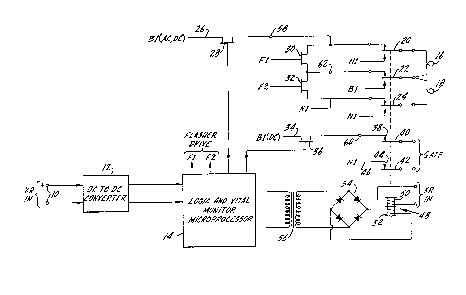Une partie des informations de ce site Web a été fournie par des sources externes. Le gouvernement du Canada n'assume aucune responsabilité concernant la précision, l'actualité ou la fiabilité des informations fournies par les sources externes. Les utilisateurs qui désirent employer cette information devraient consulter directement la source des informations. Le contenu fourni par les sources externes n'est pas assujetti aux exigences sur les langues officielles, la protection des renseignements personnels et l'accessibilité.
L'apparition de différences dans le texte et l'image des Revendications et de l'Abrégé dépend du moment auquel le document est publié. Les textes des Revendications et de l'Abrégé sont affichés :
| (12) Brevet: | (11) CA 1281116 |
|---|---|
| (21) Numéro de la demande: | 1281116 |
| (54) Titre français: | DISPOSITIF SEMICONDUCTEUR POUR LE CONTROLE DES SIGNAUX LUMINEUX ET DES BARRIERES D'UNE VOIE FERROVIAIRE |
| (54) Titre anglais: | SOLID STATE RAILROAD LIGHTS/GATE CONTROLLER |
| Statut: | Durée expirée - après l'octroi |
| (51) Classification internationale des brevets (CIB): |
|
|---|---|
| (72) Inventeurs : |
|
| (73) Titulaires : |
|
| (71) Demandeurs : |
|
| (74) Agent: | RICHES, MCKENZIE & HERBERT LLP |
| (74) Co-agent: | |
| (45) Délivré: | 1991-03-05 |
| (22) Date de dépôt: | 1987-06-25 |
| Licence disponible: | S.O. |
| Cédé au domaine public: | S.O. |
| (25) Langue des documents déposés: | Anglais |
| Traité de coopération en matière de brevets (PCT): | Non |
|---|
| (30) Données de priorité de la demande: | S.O. |
|---|
SOLID STATE RAILROAD LIGHTS/GATE CONTROLLER
Abstract of the Disclosure
A railroad crossing lights/gate controller for effecting
operation of the crossing lights and lowering of the crossing gate
during normal train operating conditions and during a gate con-
troller failure mode includes a train sensing input, a gate con-
trol circuit, a lights control circuit, a solid state logic and
monitor circuit and a fail/safe relay. The train sensing input
provides one signal condition when the approach of a train is
sensed and another signal condition when no train is sensed. This
input is connected to the solid state logic and monitor circuit
which is also connected to the gate control circuit and the lights
control circuit. The gate control circuit has power applied
thereto to maintain the gate in a raised position when the train
sensing input indicates a no train condition and the lights con-
trol circuit has power supplied thereto to operate the lights in
a flashing condition when the train sensing input indicates the
approach of a train. The logic and monitor circuit applies and
removes power to the gate and lights control circuits in accord-
ance with the signals at the input. The fail/safe relay is con-
nected to the logic and monitor circuit and to the gate and lights
control circuits to automatically remove power to the gate control
circuit and apply power to operate the lights in the event no pow-
er is applied thereto. The logic and monitor circuit further
senses the application of power to the gate control circuit and
to the lights control circuit and removes power to the fail/safe
relay under certain sensed conditions.
Note : Les revendications sont présentées dans la langue officielle dans laquelle elles ont été soumises.
Note : Les descriptions sont présentées dans la langue officielle dans laquelle elles ont été soumises.

2024-08-01 : Dans le cadre de la transition vers les Brevets de nouvelle génération (BNG), la base de données sur les brevets canadiens (BDBC) contient désormais un Historique d'événement plus détaillé, qui reproduit le Journal des événements de notre nouvelle solution interne.
Veuillez noter que les événements débutant par « Inactive : » se réfèrent à des événements qui ne sont plus utilisés dans notre nouvelle solution interne.
Pour une meilleure compréhension de l'état de la demande ou brevet qui figure sur cette page, la rubrique Mise en garde , et les descriptions de Brevet , Historique d'événement , Taxes périodiques et Historique des paiements devraient être consultées.
| Description | Date |
|---|---|
| Inactive : Lettre officielle | 2009-01-27 |
| Inactive : Périmé (brevet sous l'ancienne loi) date de péremption possible la plus tardive | 2008-03-05 |
| Lettre envoyée | 2006-08-24 |
| Lettre envoyée | 2006-08-24 |
| Lettre envoyée | 2006-08-24 |
| Lettre envoyée | 2006-08-24 |
| Lettre envoyée | 2005-07-21 |
| Lettre envoyée | 2004-04-28 |
| Accordé par délivrance | 1991-03-05 |
Il n'y a pas d'historique d'abandonnement
| Type de taxes | Anniversaire | Échéance | Date payée |
|---|---|---|---|
| TM (catégorie 1, 7e anniv.) - générale | 1998-03-05 | 1998-02-17 | |
| TM (catégorie 1, 8e anniv.) - générale | 1999-03-05 | 1999-02-18 | |
| TM (catégorie 1, 9e anniv.) - générale | 2000-03-06 | 2000-02-10 | |
| TM (catégorie 1, 10e anniv.) - générale | 2001-03-05 | 2001-02-16 | |
| TM (catégorie 1, 11e anniv.) - générale | 2002-03-05 | 2002-02-07 | |
| TM (catégorie 1, 12e anniv.) - générale | 2003-03-05 | 2003-02-04 | |
| TM (catégorie 1, 13e anniv.) - générale | 2004-03-05 | 2003-12-16 | |
| Enregistrement d'un document | 2004-04-02 | ||
| TM (catégorie 1, 14e anniv.) - générale | 2005-03-07 | 2005-02-07 | |
| Enregistrement d'un document | 2005-03-23 | ||
| TM (catégorie 1, 15e anniv.) - générale | 2006-03-06 | 2006-02-07 | |
| Enregistrement d'un document | 2006-07-13 | ||
| TM (catégorie 1, 16e anniv.) - générale | 2007-03-05 | 2007-02-19 |
Les titulaires actuels et antérieures au dossier sont affichés en ordre alphabétique.
| Titulaires actuels au dossier |
|---|
| SAFETRAN SYSTEMS CORPORATION |
| Titulaires antérieures au dossier |
|---|
| RONALD W. SNEE |